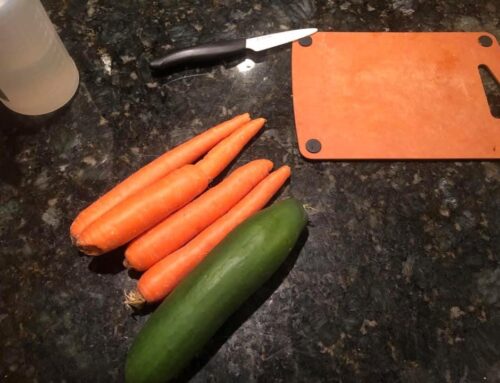Foodies and Health Nuts rejoice! Humanity has never had more options and choices for food! There has never been a better time to find niche foods, unique produce and rare ingredients for cooking and dining! Not only do options abound, but so do variety – in type and quality. Many stores are stocking the shelves and produce aisles with products labelled to engage the health-conscious consumer – “gluten-free”, “non-GMO”, “Paleo”, and “organic”, to name a few. It can be confusing. And expensive. So what are we, as shoppers, to do? We will get into that, but first…
Let’s focus on the label “organic” – in terms of fruits and vegetables.
Many people believe that consuming organic produce is the way humans should eat to be healthy. Others look at the studies and science which aren’t necessarily conclusive. With that being said, it is hard for science to prove a negative; such as “the subject didn’t have cancer due to eating organic produce for 20 years”. Such claims are hard to prove and such studies are difficult to accomplish. As with so many things in life, the truth is probably somewhere in the middle between both camps.
One of the big arguments for eating organic produce is that it is free from chemicals in pesticides, herbicides, and fertilizer. The point of those chemicals is certainly to help the farmer produce more produce to sell to consumers – not to improve your health. Also, consider this: if a chemical sprayed on a plant is intended to kill an insect, won’t that chemical also be harmful to a human? The degree of harmfulness is certainly debatable. So we rely upon government agencies to make recommendations, restrictions and regulations on the use of such chemicals. However, a lack of long-term studies, vast areas of responsibility, limited budget, government bureaucracy, and so on all limit the effectiveness of the government in this process.
So private organizations and grass-roots movements have come into play. One notable non-profit is the Environmental Working Group (www.ewg.org) who, among other things, checks produce for chemicals and annually produces lists called The Dirty Dozen and Clean Fifteen as a guide for shoppers. These lists are of twelve conventionally-grown fruits and vegetables that typically contain a lot of chemicals (and thus consumers should purchase the organic variety) and fifteen conventionally-grown fruits and vegetables which do not typically contain chemicals (and as such are acceptable as non-organic produce). This doesn’t mean you should pass over organic varieties of the Clean Fifteen produce in the shopping aisle. It just means that when you are comparing prices and trying to be economical, to get the most bang for your buck (or should we say: “health for your hard-earned dollar”) focus spending money on the organic versions of the Dirty Dozen versus the organic versions of the Clean Fifteen. If your food budget allows you to purchase organic Clean Fifteen produce (lucky you!) than certainly do so!
The list can be found on the EWG website (www.ewg.com), through Google Images, or in many books. Take a screenshot of it or save a document to your phone so that the next time you are grocery shopping it will be handy. We’ll provide the 2020 list here to for the sake of discussion:
The Dirty Dozen
- Strawberries
- Spinach
- Kale, collard & mustard greens
- Nectarines
- Apples
- Grapes
- Bell & Hot Peppers
- Cherries
- Peaches
- Pears
- Celery
- Tomatoes
The Clean Fifteen
- Avocado
- Sweet Corn*
- Pineapple
- Onions
- Papaya
- Sweet Peas (Frozen)
- Asparagus
- Honeydew Melon
- Kiwi
- Cabbage
- Mushrooms
- Cantaloupe
- Mangos
- Watermelon
- Potatoes
*(Corn is one of the most genetically modified foods, known as Genetically Modified Organisms (GMO), in our society. While the Clean Fifteen lists Sweet Corn as acceptable from the perspective of chemical contaminants, there are other concerns with GMO food which we will discuss later. By rule, if something is labelled “organic” it is also GMO-free. Consider buying non-GMO corn – which applies to your corn chips too!)
Do you see a trend on these lists? Another good rule of thumb when purchasing non-organic produce is if there is non-edible skin or rind which will block pesticides, herbicides and chemicals from the portion you will eat. Many of the items on the Clean Fifteen List do have an external protective layer (Note: bananas aren’t on the Clean Fifteen List but do certainly have an inedible peel) while none of the Dirty Dozen do. This rule of thumb applies to plenty of other fruits and vegetables which aren’t on either of these lists as well.
Other factors that may guide your produce shopping choices are local grown vs. internationally harvested, frozen vs. canned vs. fresh produce, seasonal vs. out-of-season, and refrigerated vs. room temperature storage. We will talk more about these soon. Until then, feel free to do your own research – Google, Podcasts, Social Media, Youtube, etc. Or if you’d like to discuss this more, have questions, please talk to one of the Coaches at BCI!
[Comment: It should be noted that, according to their own website and annual reports, some funding for the EWG does come from producers of organic food products]



Leave A Comment